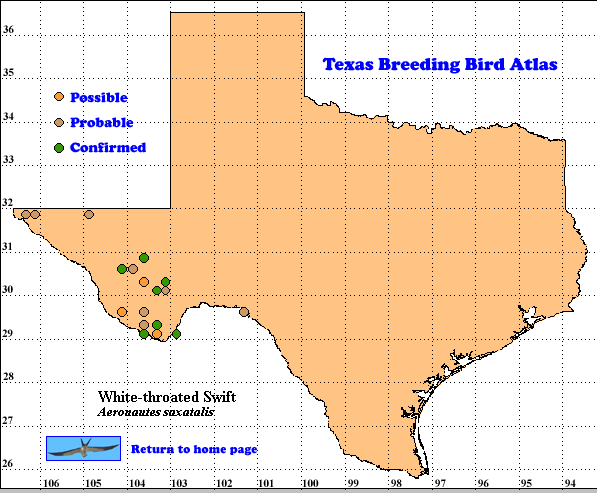Aeronautes saxatalis
Although White-throated Swifts are often seen foraging for insects in the air, darting like “flying cigars”, placement of many nests far back in crevices at inaccessible places on cliffs or structures, makes gathering basic biological data difficult (Harrison 1979, Ryan and Collins 2000).
DISTRIBUTION. During the 1987-1992 field work of the TBBA project, atlasers found White-throated Swifts breeding in the Trans-Pecos region with 2 probable records in latilong 31106 (El Paso County including the Franklin Mountains and Huecho Tanks), and 6 probable and 4 possibles records in 31104 (Guadalupe Mountains). In the area around the Davis Mountains, there were 1 confirmed, 2 probable and 1 possible in 30104; there were 3 confirmed, 2 probable and 2 possible in 30103. In Big Bend National Park there were 1 possible in 29104; 2 confirmed, 2 probable and 1 possible in 29103 and 1 confirmed in 29102. Oberholser (1974) and Lockwood and Freeman (2004) indicate the species is present all year in these areas, suggesting the 17 Trans-Pecos locations shown on the map below may all represent breeding sites. In the Edwards Plateau region 3 probable and 1 possible records were found in latilong 29101.
In other areas, a migratory population breeds in British Columbia, eastern Washington, Idaho, western Wyoming and western South Dakota south to Nevada and the higher elevations of Arizona and New Mexico. After breeding this population moves south to a year-round range in the mountains of California, Baja California, Mexico, western and southern Arizona, southern New Mexico and mainland Mexico and Guatemala (Howell and Webb 1995, Ryan and Collins 2000).
SEASONAL OCCURRENCE. White- throated Swifts are present all year at their breeding colonies in the Trans-Pecos. Migrants move through the area from early March to early May. Breeding probably occurs from May to mid-July, and southbound migrants are present from early September to late November. Wintering populations have also been found in the Panhandle at Palo Duro Canyon and Caprock Canyon state parks (Oberholser 1974, Lockwood and Freeman 2004). In Arizona breeding has been recorded from mid-March to early August (Wise- Gervais 2005) and in Colorado from early May to mid-August (Boyle 1998).
BREEDING HABITAT. Much of the breeding of White-throated Swift occurs in crevices in cliffs or canyon walls (about 70% in Colorado; Boyle 1998), but these birds also use human- created crevices in road cuts, quarries, buildings, bridges and stadiums (Ryan and Collins 2000).
Nests, shallow saucers of feathers, grasses, moss and other plant materials, are placed on flat surfaces in crevices, felted and glued together with the bird’s saliva. The average diameter is about 10 cm (4 in). The female usually lays 4-5 (range 3-6) white or pale creamy white eggs, sometimes marked by the excrement of nest parasitic insects. The eggs hatch about 24 days after egg-laying (Ryan and Collins 2000). More data are needed on nesting biology.
STATUS. Oberholser (1974) and Lockwood and Freeman (2004) describe White-throated Swift as common in summer and locally uncommon in winter in the Trans-Pecos region. Data from three 40-km (25-mi) North American Breeding Bird Survey (BBS) routes in the Trans-Pecos show relative abundances of <1 to 1-3 swifts per route (Sauer et al. 2005).
BBS data for Texas are too limited to provide meaningful population trend estimates, but results from 197 routes in the United States and Canada yield a 95% confidence interval (There is a 95% chance that the actual population trend will be between these two numbers.) of -4.8 to +1.4% population change per year for the period 1966-2004 (Suer et al. 2005). The lack of any striking change since 1970 (Oberholser’s [1974] map shows a range very similar to the TBBA map below) and the relatively slow decline of this species across its range are favorable signs for the future of this swift in Texas.
Text by Robert C. Tweit (2005).
Literature cited.
Boyle, S. 1998. White-throated Swift (Aeronautes saxatalis). In Colorado breeding bird atlas, pp. 240-241 (H. E. Kingery, ed.), Colorado Bird Atlas Partnership, Denver.
Harrison, H. H. 1979. A field guide to western birds’ nests. Houghton Mifflin, Boston, MA.
Howell, S. N. G. and S. Webb. 1995. A guide to the birds of Mexico and northern Central America. Oxford University Press, New York.
Lockwood, M. W. and B. Freeman. 2004. The TOS handbook of Texas birds. Texas A&M University Press, College Station.
Oberholser, H. C. 1974. The bird life of Texas. University of Texas Press, Austin.
Ryan, T. P. and C. T. Collins. 2000. White-throated Swift (Aeronautes saxatalis). In The birds of North America, No. 526 (A. Poole and F. Gill, eds.). The Birds of North America, Inc., Philadelphia, PA.
Sauer, J. R., J. E. Hines, and J. Fallon. 2005. The North American Breeding Bird Survey, results and analysis 1966-2004. Version 2005.1. USGS Patuxent Wildlife Research Center, Laurel MD (Web site, http://www.mbr-pwrc.usgs.gov/bbs).
Wise-Gervais, C. 2005. White-throated Swift (Aeronautes saxatalis). In Arizona breeding bird atlas. pp. 240-241 (T. E. Corman and C. Wise-Gervais, eds.), University of New Mexico Press, Albuquerque.
